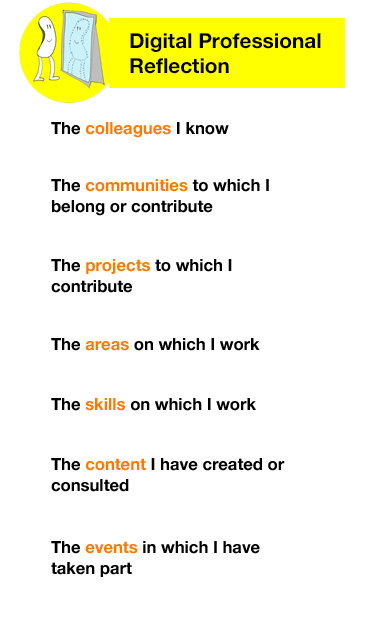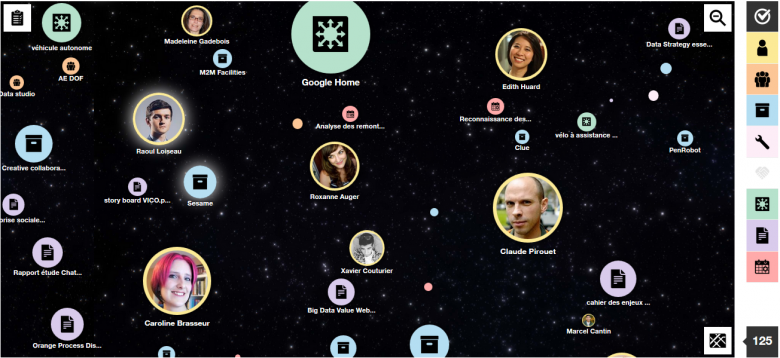 What is a Digital Professional Reflection? It is the list of characteristics that describes who you are as a company employee (see image to the right). This digital description is obtained via Natural Language Processing of employee data, such as files on their drives, mailboxes or data from specific business applications (collaborative network, SharePoint, etc.) This intelligent algorithm, developed by a research team at Orange, extracts keywords that it then categorises (into groups such as community, project, content, etc.) and weighs, by counting the number of occurrences, for instance.
What is a Digital Professional Reflection? It is the list of characteristics that describes who you are as a company employee (see image to the right). This digital description is obtained via Natural Language Processing of employee data, such as files on their drives, mailboxes or data from specific business applications (collaborative network, SharePoint, etc.) This intelligent algorithm, developed by a research team at Orange, extracts keywords that it then categorises (into groups such as community, project, content, etc.) and weighs, by counting the number of occurrences, for instance.
We have chosen to call our algorithm Digital Reflection because, while it is a reflection of what the data is “saying”, it is not a comprehensive stocktaking of a person’s work (the reflection can be more or less distorted). This reflection is also professional because it presents an analysis of work-related data and extracts professional information from it. It does not include any private personal data (unless this has been mixed with work-related data, and in such cases, employees can personally remove it, if they wish).
Digital Reflection provides employees with a better understanding of the extent of their achievements, areas of work and communities (self-assessment). It gives them more control over their professional lives. Is my digital mirror-image in keeping with what I want to be or do at this point in my career? What do I need to change or do more of to meet my personal development objectives? Employees can easily find completed work or the groups to which they belong (pointers for finding documents or communities).
Of course, to ensure secure use, each Digital Professional Reflection must be visible only to its owner. Disclosing all or part of an employee’s description would be in breach of Orange’s personal data protection commitments.
Recommending resources to employees…
This list of characteristics will make it possible to identify crossovers between an employee’s needs and the company’s resources, thus allowing employees to be offered what could be most useful to them by calculating the intersection between an employee’s digital reflection and the digital reflection of a document, for example. The term “resources” here covers employees, communities, projects, areas, skills, content and events that constitute the assets of a business.
Recommendations are made via an interactive “map”. “Map” mode gives employees an overview of their actual ecosystem (as opposed to their known ecosystem) and allows them to browse resources, make new contacts, discover documents, and more. It is like a watchtower for each employee.

Figure 1: Map of corresponding resources
Expected impact on the work of an organisation’s employees
When a company uses an assistant like this, it can have several impacts, five of which can be assumed:
Transversality: It is easier for employees to break through the internal barriers of the business organisation, to be familiar with and access any resource, wherever it may be.
Effectiveness and relevance: Employees are given the right information as they conduct their business (not afterwards as is usually the case). As such, employees avoid duplicating work and are informed as early as possible, which improves the quality of their work.
Independence: Employees become more independent because they can rely less on other resources (nearby colleagues, their manager, HR) to find the information they need.
Self-awareness: Digital reflections can give employees an insight into the working “self” and the scope of their professional “domain”. This could help employees to see themselves in a more positive light, to notice what they are bringing to the company and to take stock of their development.
Knowledge of one another and company support: By helping employees to better understand one another and to forge relationships with colleagues throughout the organisation, this tool can turn team spirit into company spirit and strengthen employees’ commitment to their organisation.
These positive assumptions will soon be tested by users in order to identify any potential adverse effects, such as the exclusion of certain employees. As such, this tool will be tested in 2020.
Business impact
If employees with a sense of independence and empowerment are choosing their own positions and projects, what then becomes of the team manager’s role within the organisation?
By bringing people together, no matter where they are in the organisation, these tools can also connect them, no matter where they are on the planet, thus facilitating remote working (multi-site project teams). And in terms of logistical organisation, what impact could this tool have on facilities management, travel, telecommuting and any other matters relating to the geographical location of company employees?
According to Folcher, tool development projects, such as Digital Reflection, designed out of a desire for transformation, “are an opportunity to instigate new forms of actor engagement within organisations and institutions.”
This assumption is based on the fact that an “enabling” tool will allow for a change in how employees work and impact their organisations, as well as encouraging a better knowledge of one another, by making previously unknown resources visible. The goal is to encourage independence and give organisations within the company greater corporate plasticity.
In conclusion, introducing this technical device goes hand in hand with operational transformation. This means that an integrated approach between the organisation and its tools is crucial, unless these tools are to be of limited use, which is far from the company’s ambition to improve the internal flow of information and knowledge. The purpose of an assistant like the one described in this article is to increase agility within the company. It therefore marks a vital step towards an “enabling” organisation, taking value from both the available data and human abilities. It is clear that the innovation of such a tool lies not only in its design but also, and above all, in the nature of its ownership.

Figure 2: The three employee assistant modules
Learn more
Arnoud, J., & Falzon, P. (2013). Changement organisationnel et reconception de l’organisation: des ressources aux capabilités.
Chêne, A., & Le Goff, J. (2017). Les entreprises peuvent-elles faire confiance à la confiance: Une exploration du lien contrôle-confiance comme principe organisationnel. Revue internationale de psychosociologie et de gestion des comportements organisationnels, vol. xxiii(56), 185-204.
Folcher, V. (2015). Conception pour et dans l’usage: la maîtrise d’usage en conduite de projet. Journal of Human Mediated Interactions (Vol 16)., 39-60.
Hervé, M. (2007). De la Pyramide aux Réseaux. Autrement.
Rabardel, P. (1995). Les Hommes et les technologies; approche cognitive des instruments contemporains. Armad Colin.
Villemain, A., & Lémonie, Y. (2014). Environnement et engagement des opérateurs : une mise en débat à partir de l’activité des techniciens de la base polaire Dumont d’Urville. Activités.











